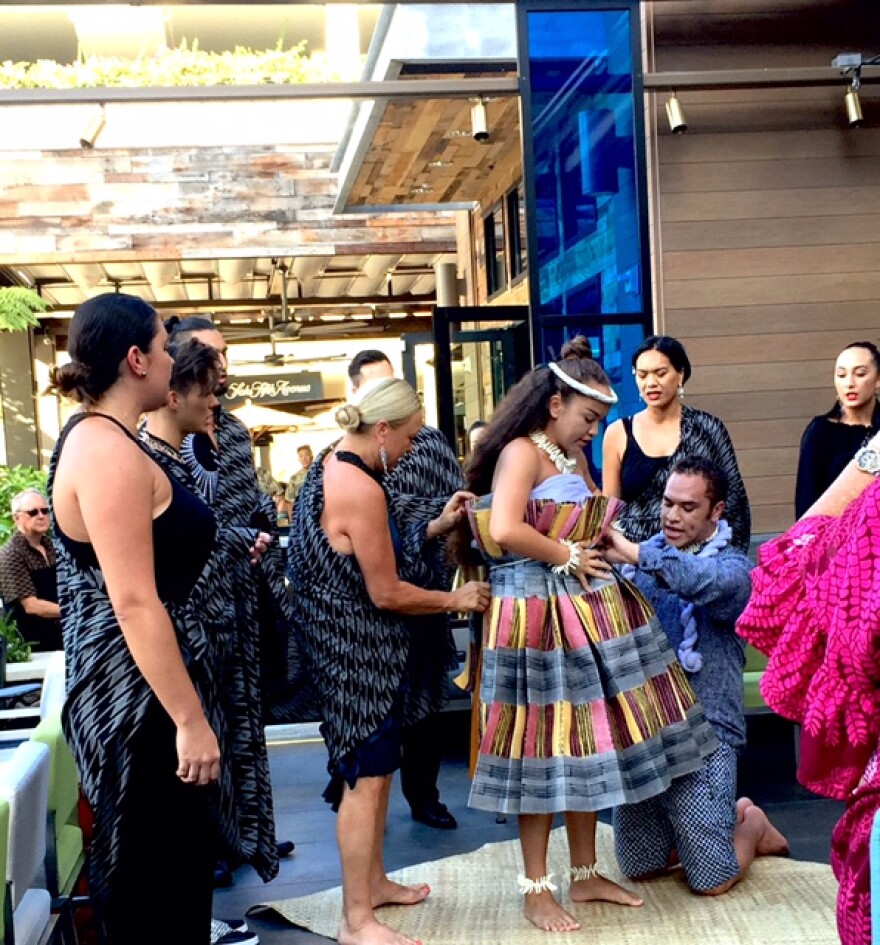Hawai‘i fashion has an international profile that started with grass skirts and coconuts bras, through sarongs and Shaheen’s silks, then mu‘umu‘us, aloha shirts, and jams of the later twentieth century. Contemporary local fashion is now emerging and this week, for the first time, a native Hawaiian will debut his collection in New York’s Fashion Week. HPR’s Noe Tanigawa reports.

Manaola Yap grew up in the hula world. His mother is a kumu hula and he remembers as a child gathering plants, leaves, dirt, and other materials to make fabric dyes for costumes and implements.

Manaola: A lot of my beginning started at home on the Big Island mostly with mom and hula and all that. All the adornments, all the associated arts to the dance, played a crucial role in putting my future career together. I used a lot of family, ancestral traditions through costume making, implement making, and taking all of that and fusing it. Now, seeing today how valuable those early lessons were for me.
I first saw your work on the MAMO Wearable Art runway. You’d do these one off art pieces and be gone!
Manaola: The MAMO Wearable Art Show which is done by Aunty Vicky Holt Takamine and the Pa’i foundation is a wonderful platform for native artists and really helped to push our native arts into another realm. It was an inspiration and an honor to be a part of those early years.
Creating individual wearable art pieces. You didn’t sell those.
Manaola: I did do one off pieces for close family friends and people that I knew and admirers of the Wearable Art Show. A lot of my MAMO Arts pieces were a little bit more on the sustainable side, I had a lot of pieces that were made out of recyclables, coconut fibers, hangers, crazy things like that.

Really fun! And wild like high fashion looking. The look was always there. Yap was drawn to making ‘ohe kapala, the bamboo stamps used for printing kapa. Carving bamboo lends itself to geometric patterns, diagonals, diamonds, chevrons, and other shapes, nothing like florals or Maori tattoo designs. Yap adapted his patterns for fabric printing and there, had the basis for a new look.
Then several years ago, after doing only pop ups, Manaola had the opportunity for Hula Lehua, a shop at Ala Moana Center, and the look had a home base.
Last year you were at Honolulu Fashion Week which is meant to be another lift for Hawai‘i artists.

Manaola: Yes, we did Honolulu Fashion Week which is put on by Honolulu Magazine, Hawaiian Airlines and Lyn O’Neill. That was such an amazing event, I do believe tits not having it this year, but the amount of professionalism and what they offered to local designers here in Hawai‘i was incredible. It’s unfortunate but I believe they’re looking to bring it back maybe next year.
If this story can help bring it back, let it be so. Because through that event, you sparked!
Manaola: Exactly. We were actually looked at through Oxford Fashion Studios. They are a London based, UK fashion company they also help run London Fashion Week. They have shows in all the four major fashion capitals. They had come across our profile during Christmas time and had given us news on New Year’s day, I think it was January first or second they reached out on email and said their curators had reviewed eight thousand profiles and we were one of the 26 that were chosen to show. We’re going to start at New York Fashion Week.
Manaola’s mother is the multi-talented Nani Lim Yap, member of the legendary Lim family of singers and entertainers. Her h?lau (hula school), now called H?lau Manaola, is where Manaola began making costumes, implements, and dressing the dancers.

Nani Lim Yap: The muumuu was something that was part of our history and it just dated everybody to that time, you know those big flowered prints? They have their time and their place in our history and it’s a good place but he wanted to bring Hawaiian fashion, to change it really, to turn it on its head and try to use patterns that were native use of ‘ohe kapala, printed patterns, and make modern day dresses.
Nani Lim Yap: The times were changing, but our fashion wasn’t coming up to it. It wasn’t identifiable to us, as Hawaiians, that’s how he felt.
Manaola: My mom has always been a big part of mentoring me and helping to bring a lot of my creations to life, especially my early creations and my early development as an artist in fashion. And even this collection, she helped to sew and construct and pattern a lot of the pieces that will be shown in New York.
To imagine these fashions, think Game of Thrones. Some of Manaola’s new pieces feature earth colors, flowing garb in rich browns and forest greens, shot with gold. Attention grabbing white resort wear

features sweeping fringe and body conscious cut outs. And there is menswear—collared shirts to tank tops and smoking jackets.
Manaola: The line we are showing is called Kolani, it’s named after the seated dance that was meant to honor Hawaiian royalty. What kolani is, is I wanted to If our monarch were still in power right now and if I as a native designer had to dress these celebrities, these iconic monarch figures, how would I do it? Our ali‘i were always into travelling the world, they were into popular culture, so I wanted to put that together and see how I would style them around the world.
There’s a collection of men’s bags, in canvas and leather. ‘Ohe kapala prints look almost like hounds’ tooth, in lambskin, on stiletto heels. Look out!




